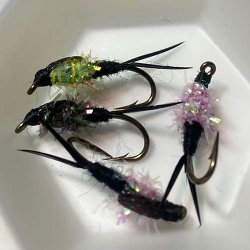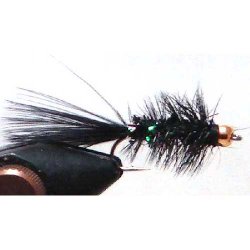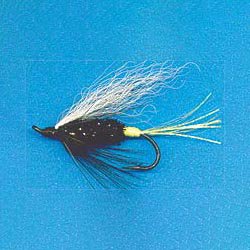Micro Ice Chenille
Fuzzy metallic ideal for bodies. Smaller than regular Ice Chenille.
-
Micro Ice Chenille Ideas from Harrison Steeves
Marvelous Micro Ice Chenille: ideas for using this fuzzy metallic for fly fishing lures
by Harrison Steeves III
If you have ever tied anything using standard size ice chenille, or one of the similar products, you may have done what I have: you looked at the fly, held it up to the light, and thought, “Boy, if I could just find something in a smaller diameter, I could tie some neat little streamers instead of these monsters.” Well, here it is. Kreinik Micro Ice Chenille is about half the diameter of regular ice chenille, which has allowed me do a lot of things I used to only dream about.
I use the Micro Ice Chenille for many purposes:
- You can use it to wrap bodies on patterns such as Woolly Buggers, Sculpins, Zonkers, Muddler Minnows, and other assorted streamers.
- It also makes fantastic bodies on salmon and steelhead flies, big Zug Bugs and Prince Nymphs (I use Kreinik color 850 Mallard for these), Clouser Minnows, Deceivers, and a host of other flies.
- I have tied quite a few of the Crazy Charley patterns using Micro Ice Chenille for the body wrap, and it allows me to tie the smaller sizes (which many times seem to outfish the bigger ones) with no trouble whatsoever. As a matter of fact, one of the most well-known Christmas Island bonefish guides went ballistic over the material a few years ago at the International Fly Tackle Dealer Show in Denver.
Other than the obvious use of this material to wrap bodies on subsurface flies of all types, what else can you do with it? Actually, it has quite a few other applications you might want to try
- I have used it to wrap the bodies of both hopper and cricket patterns. While I'm not going to make any generalizations, there have certainly been days when these have outfished their regular counterparts. One of the patterns is simply a Letort Cricket tied with a body of either Black, Mallard or Peacock Micro–Ice (which Rob Cramer, former owner of the Mossy Creek Fly Shop in Virginia, introduced to the general public as the Disco Cricket). For a number of years, I have been tying a Letort Hopper, a la Ed Shenk, with a body formed from yellow Micro Ice Chenille, and I have been very pleased with the results. I suppose this should be named the Disco Hopper?
- The material is small enough in diameter to use it for the thorax on many of the nymph patterns, as was done on Steeves' Braided Bitch and some of the other nymph patterns marketed through Umpqua. You might want to give this a try on some of your favorite nymph patterns; it does away with the mess associated with dubbing and forms a wonderful fuzzy, sparkling thorax that just seems to naturally attract fish.
- I have been tempted to use the Micro Ice Chenille for the body wrap on some of the really large dry flies; something like a great big Humpy or Wulff pattern could be very interesting. What about using it for the body on some of the big stonefly patterns, or on the Madame X, Tarantula, Stimulator, or some of the damsel and dragon fly dry fly patterns? Any big pattern loaded with deer hair, foam, hackle, elk hair, caribou or some other highly floatable material is certainly a candidate for trial. Try these ideas and let me know what happens; I promise I won't tell anybody else.
Helpful Hint: Try the following if you really want to produce a wrap in which the material in any of the "Ice Chenilles" is absolutely and irrevocably locked in place... Instead of tying in a strand of Micro Ice Chenille and wrapping it in the usual manner, tie it in as a loop. In other words, tie in both ends to form a loop in the same way that you would form a dubbing loop using thread. Then, using a dubbing spinner hooked in the closed end of the loop, twist the two strands together before wrapping the material forward. Using this procedure assures you that all of the little glittery pieces in the strand will never fall out. Also, it does not increase the diameter of the material and it gives a fuller and more luxuriant wrap.

-
How to use Micro Ice Chenille
Kreinik Micro Ice Chenille is the perfect metallic chenille for bodies on any size lure. Wrap once, twice, or as many times as desired. Combine it with Kreinik Braids, Ribbons and Flash for the most effective fly fishing lures you'll ever use. Experiment and have fun with this fiber.
Watch fly tyer Val Roberts using Kreinik Micro Ice Chenille (the pink) and Kreinik Flash (the red) to make a body on this scud-like fly. In addition to the metallic shimmer and fuzzy texture, the pink chenille has some UV properties.
Here Val uses Micro Ice Chenille to replicate a catepillar:
-
Micro Ice Woolly Bugger Pattern
This item is not shipped
Replace peacock herl with Kreinik Micro Ice Chenille. Our peacock color is known as Peacock Herl on steroids.
Materials Needed & Instructions:- 6/0 thread - Black
- 3x streamer hook
- Gold Bead 1/8 - 5/32
- Black marabou
- Kreinik Micro Ice Chenille (Peackock or any other color)
- Kreinik Flash In A Tube 006HL – Blue Hi Lustre
- Grizzly saddle hackle
1.) Place the bead on your hook. You may need to crimp down the barb of the hook. Tie on your thread and wrap all the way to the curve of the hook.
2.) Measure a piece of Marabou about the same length as the shaft of the hook. Use a pinch wrap to tie on the marabou. This forms the tail. Trim off the excess. Tie in 4-8 strands of the Kreinik Flash In A Tube around the tail, and trim them to the same size as the tail.
3.) Tie the Kreinik Micro Ice Chenille & a saddle hackle feather at the tail. Tightly wrap the chenille (not the hackle) forward to a point just behind the hook eye. Tie off the braid, and trim the excess.
4.) Wrap the hackle forward, and secure it at the head. Trim the excess, and add a whip finish to the fly.
Fishing These Flies:
The great thing about Woolly Buggers is that there is no wrong way to fish this fly. Add some weight to the fly or use a sink tip line to get you fly down deep and dead drift it. Use the same technique and strip it. Add even more weight to your tippet and bounce it along the bottom. Try an un-weighted version to fish along the surface and strip the fly in. This fly simply produces whether you are fishing the smallest mountain stream, large impoundments even in saltwater. -
Green Butt Skunk Pattern
This item is not shipped
Green Butt Skunk
Modified by Ray Larsen
Materials Needed:
- Hook: Salmon #2 - #8
- Thread: 6/0 - Black
- Wing: White Calf Tail
- Tail: 10 strands of Kreinik Flash In A Tube™ in (#054F) Glow In The Dark Yellow, or (053F) Glow In The Dark Green
- Butt: 1 strand of Kreinik Flash In A Tube™ in (#054F) Glow In The Dark Yellow, or (053F) Glow In The Dark Green
- Body: Kreinik Micro Ice Chenille - (#005) Black
- Throat: 3-4 turns of folded black saddle hackle
Tying Directions:
- Start at the tail. Tie in about 10 strands of Kreinik flash so that they extend about 1" past the bend of the hook.
- After tying off the tail material, wrap over the tailing material with the single strand of Kreinik flash to form the butt. After about 7 or 8 wraps, tie off flash.
- Wrap you thread forward to a point about 1/4" from the eye of the hook. To form the body of the fly tie in the Micro Ice Chenille and wrap the chenille rearward, and then wrap back forward and tie off at the same point where you tied it in.
- To form the throat hackle, tie in a saddle hackle, and make two wraps.
- To form the wing, tie in a clump of calf tail on top of the hook at the same point as the Micro Ice Chenille so that the calf tail extends about 1/2" past the bend of the hook.
- To finish, tie off the calf tail, and build up a neat head with your tying thread, and coat with head cement.
- Editor's Notes: Ray Larson is a guide from Sheboygan, Wisconsin. Most green butt skunk patterns have a silver tinsel rib, but Ray says that the black Micro Ice Chenille is so shiny, the ribbing is not necessary.








